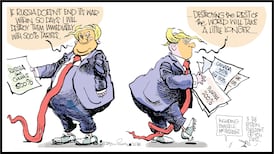Dublin City Council is planning to charge city-centre businesses an extra €20 million over five years - in addition to the annual commercial rates - to clean up the city centre. This urban enhancement scheme, if a majority of businesses in the area agree to support it, would greatly improve the appearance of the capital city. The clean-up measures would involve power-hosing the streets every day, emptying litter bins more often, quickly removing graffiti signs from buildings and lifting chewing gum from the pavements. What a difference such a scheme could make, turning a great city into a beautiful city.
Similar initiatives in city centres in New York and Toronto have been a notable success, resulting in the transformation of districts, like Times Square. Dublin now deserves, indeed needs, a facelift and, at a cost of €4 million a year for five years, the extra cost to local business could be recovered over time. Certainly a cleaner and safer city centre, which includes the Financial Services Centre, would be a more attractive place to work. A better urban environment would also prove more attractive to shoppers and visitors and help to generate extra revenue. A civic-minded gesture now from business, by giving their financial support to this scheme, would also make good business sense.
This initiative by the city council to clean up the centre of Dublin also represents a welcome local attempt to tackle what has become a national problem, but a problem still awaiting a national solution. That is the proliferation of graffiti marks, both in Dublin and outside, which are blighting so many urban and rural landscapes. The spray-painted marks on walls, the defacing of buildings and the damage to property, public and private, rightly have been called graffiti vandalism. The official response, however, has been a piecemeal one, which has proved quite inadequate. Too many State and local agencies have different responsibilities for dealing with aspects of graffiti vandalism, but with little co-ordination of their activities. The relevant laws in this area, the Criminal Damage Act 1991 and the Litter Pollution 1997, fail to provide an adequate legal remedy. Prosecutions for acts of graffiti vandalism are infrequent.
Last November in the course of a Dáil debate, John Gormley, as a Green Party TD, raised the issue of graffiti vandalism. And he promised that in office, the party would deal with it, both by introducing "specific legislation", and through a co-ordinated targeted approach to the problem. Little did he know then that he might be so well placed so soon, as Minister for the Environment, to act on his promise. He should do so, without delay.










